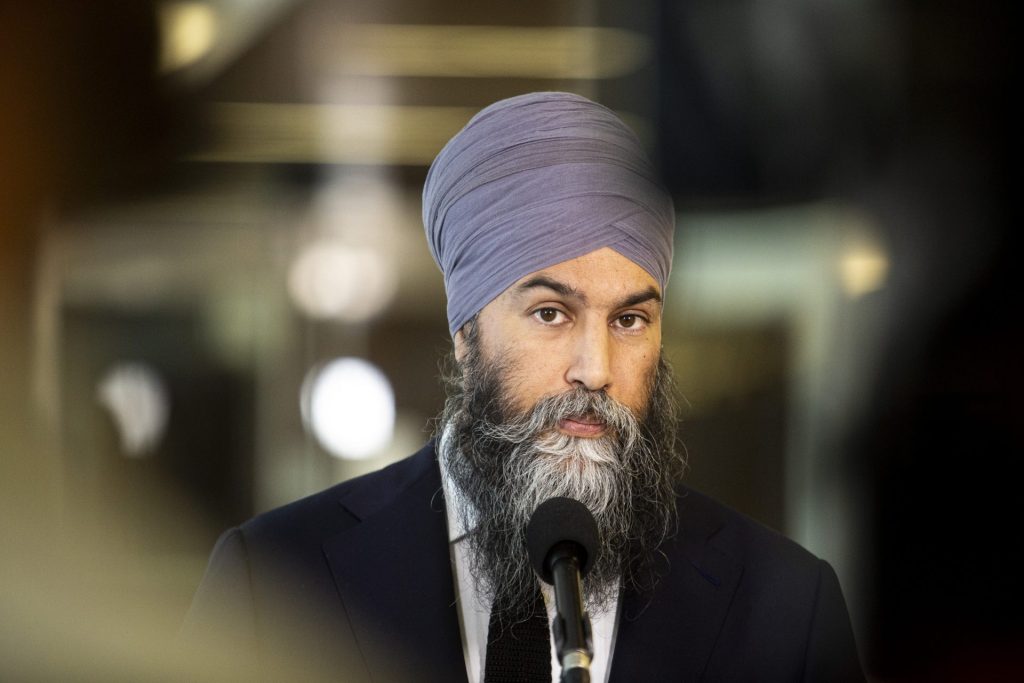Third-party Protecting Canada goes on $4M TV ad attack targeting Conservative leader’s record on pensions, dental care

As the Conservatives continue to spare no expense to pre-define the next Liberal leader as that race heats up, the third-party group Protecting Canada is back with a seven-figure television ad campaign to take another run at reintroducing the Tory leader to Canadians.
Protecting Canada’s latest $4-million television advertising blitz, Pensions, focuses on Conservative Leader Pierre Poilievre’s (Carleton, Ont.) pension in contrast with his voting record that the group says has “repeatedly voted against stronger pensions for everyday Canadians … underscor[ing] his pattern of prioritizing the wealthy and himself over working families and vulnerable seniors.”
The group says the ad is scheduled to run on major national and regional networks, timed to coincide with “high-profile TV moments,” including its premiere during United States President Donald Trump’s inauguration, and the upcoming Grammy Awards, Saturday Night Live’s 50th anniversary special, and various NHL games.
Before the television campaign, Protecting Canada also released a multi-part YouTube documentary, The Poilievre Investigations, which examined “Poilievre’s values, policies, and who he associates with … support for far-right groups, his voting record against measures to support Canadians, and his cozy ties to the rich and powerful.”
Coinciding with those videos, Protecting Canada also began purchasing digital advertising on Meta after a spending hiatus during the second half of November and all of December 2024, spending $1,054 from Jan. 6-12 before jumping to $22,878 from Jan. 13 to 19. Despite spending nothing in the last week of 2024, the group’s total spend from Dec. 26 to Jan. 25 is already more than $50,000.
According to Meta's Ad Library, the Conservatives spent a combined $234,562 on the party and Poilievre’s official Facebook and Instagram pages during the same period. The Liberals spent a fraction of that, for a combined $65,561, on Prime Minister Justin Trudeau (Papineau, Que.) and the party’s official pages, while the NDP and Leader Jagmeet Singh’s (Burnaby South, B.C.) official pages spent $18,660.
Megana Ramaswami, a Protecting Canada spokesperson, said the campaigns are about “opening voters’ eyes to the risks Poilievre poses to our future,” and “what [he] and the Conservatives really stand for.”

In an interview with The Hill Times on Jan. 22, Ramaswami said the group’s goal is “uniting progressives,” regardless of party affiliation, “to hold Poilievre and the Conservatives accountable.”
Ramaswami wouldn’t give specifics about where the group has received the money needed to mount such a high-dollar-value advertising campaign that dwarfs the Liberals' entire 2023 advertising spend—roughly $381,000, according to Elections Canada—or even the $3-million the Conservatives spent in the summer of 2023 to (re)introduce Poilievre to Canadians. According to the Tories' annual financial returns, that campaign amounted to nearly half of the party’s $8.5-million advertising spend for that year.
“The funding comes from a broad base of individual donors and organizations,” Ramaswami said, noting the group accepts donations directly on its website.
“We're finding that a wide range of everyday Canadians and organizations from all walks of life support us because they believe in the importance of protecting programs like pensions and health care for everybody,” Ramaswami continued. “This is a time when people are genuinely worried about our future and want to ensure that we are protecting the values Canadians have worked so hard for for decades.”
Ramaswami said that alongside highlighting Poilievre’s voting record, the campaign aims to highlight what they call his hypocrisy in voting against increasing pensions and the dental care program while enjoying taxpayer-funded dental care and a pension the group estimates to be valued at $3.4-million, courtesy of his job as a Member of Parliament.
An examination of the five major party leaders' pensions by CBC News last September indicated that Poilievre could receive more than $200,000 annually once he turns 65. However, the current lifetime value of Poilievre's pension is estimated to be $1.75-million, assuming he leaves politics after this year.
In comparison, Trudeau’s pension is estimated at more than $300,000 annually, with a total pension value of $2-million. Singh, who will qualify for his pension on Feb. 25, would receive more than $66,000 per year—with a total current valuation of $502,000—once he turns 65, according to the analysis by Shanker Trivedi.
As for why Protecting Canada stalled its activity in November, Ramaswami said their fall spending had laid the groundwork for the current campaign before the group took a break to plan its next steps in the new year.
She pointed to polling released by Abacus Data on Oct. 13, 2024, which indicated that during the period those fall ads were released—Sept. 12-Oct. 10—voters’ negative impression of Poilievre increased by five points to 40 per cent.
Ramaswami said the new slate of ads on digital platforms like Meta, the YouTube series, and the television campaign are intended to build on that momentum.

“I think many Canadians have genuinely worried about what a Poilievre government would look like … they don't necessarily know what he stands for; they just know that he’s the alternative,” Ramaswami explained. “And there is this growing call from Canadians to get these facts, to ensure we understand what's at stake for our future.”
Michael Roy, the NDP’s former national digital director during the 2015 federal election, told The Hill Times that while the current trend in political advertising favours the digital sphere, a big-budget television campaign remains a critical tool in any robust communications strategy.
“Negative television attack ads are by far the most economical, particularly in defining a leader,” Roy explained, noting this specific strategy had been used to significant effect before the call for British Columbia’s 2013 provincial election.
Before that election, the Independent Contractors and Businesses Association spent hundreds of thousands of dollars on ads targeting then-NDP leader Adrian Dix, who led then-B.C. Liberal premier Christy Clark in the polls.
“Those ads fundamentally defined [Dix] in the eyes of B.C. voters, and the Liberals were able to close the gap,” Roy explained, noting that a similarly successful strategy had been employed against then-federal Liberal leader Michael Ignatieff through the Conservatives’ Just Visiting ad campaign.
“These are tried and true tactics that absolutely work,” Roy told The Hill Times, noting that to make them work, the ads need to ensure the message resonates with the intended audience.
To that end, Roy noted that the combination of Protecting Canada's messaging on pensions and dental care delivered to a television audience is practical, given the age demographics of the latter’s audience.
While the internet has become the most common method for Canadians to follow news and current events (80 per cent), according to Statistics Canada’s 2020 General Social Survey, older viewers still consume more television than younger Canadians.
For Canadians aged 15 to 34, 95 per cent said the internet is their preferred source of news and information, while 88 per cent of those 55 years and older prefer television.
However, Mélanie Richer, a former communications director for Singh, told The Hill Times she isn’t convinced Protecting Canada’s framing will effectively connect with the audience it's looking for.

“The messaging is something I think a lot of people already know …the people who don't like Poilievre don't like him because of these reasons already,” Richer explained. “What needs to happen is you need to talk about how he's going to make life more expensive for you.”
Richer said the messaging should focus on the threat to Canadian family budgets rather than on the issue as a threat to Canadians' health or the social safety nets.
“If you want to hit Poilievre in a way that will bring people over to you, you need to talk about how he will make life more expensive for you because he doesn't want you to have dental care,” Richer said. “Dental care will save families approximately $1,200 a year that they can use to help pay for the rising cost of groceries or their mortgage or rent, and Poilievre wants to take that away. That's how you need to talk about it.”

As for why that message has fallen to an outsider group rather than one of the major progressive parties in the House of Commons to push, Richer noted that the NDP is doing what it can with the resources available, and doing more than it usually does between writ periods.
“The fact that they’re spending any money before the writ drops is a pretty big thing for the NDP,” Richer explained, noting the party didn’t have the money to do so in the lead-up to the 2019 and 2021 elections.
“The NDP spent almost $20-million on ads in the last election, so we can expect them to spend even more once the writ drops,” Richer added.
Roy said that despite the relatively small advertising spend from the NDP, the party is using that to build out its field programs, and lay the foundation for get-out-the-vote campaigns ahead of the next election, alongside beta-testing messages to be ready for whenever the election begins.
Both agreed the NDP should allow the Conservatives to take the lead on attacking potential Liberal leadership candidates, and said it is more important for the party to focus on defining Singh in the eyes of voters and the choice in the next election.
“They need to focus on why Singh is running for prime minister, what he will do to improve people's lives, and framing the choice between him and Poilievre,” Richer said. “If the ballot-box question is ‘change,’ then the Liberals are not the answer, so you need to frame the election as a choice between [Poilievre] and Singh if you want to change how this country is run.”
The Hill Times
Weekly Meta ad spending in January
| January Ad Spend | Dec. 30, 2024-Jan. 5 | Jan. 6-12 | Jan. 13-19 | Running January Total | Dec. 26 - Jan. 25 |
| CPC | $47,277 | $46,421 | $45,803 | $139,501 | $199,379 |
| Pierre Poilievre | $8,430 | $8,649 | $8,246 | $25,325 | $35,183 |
| Total | $55,707 | $55,070 | $54,049 | $164,826 | $234,562 |
| LPC | $14,661 | $14,124 | $1,110 | $29,895 | $41,856 |
| Justin Trudeau | $6,599 | $6,268 | $2,798 | $15,665 | $23,705 |
| Total | $21,260 | $20,392 | $3,908 | $45,560 | $65,561 |
| NDP | $6,589 | $0 | $0 | $6,589 | $12,930 |
| Jagmeet Singh | $0 | $1,012 | $2,416 | $3,428 | $5,730 |
| Total | $6,589 | $1,012 | $2,416 | $10,017 | $18,660 |
| Protecting Canada | $0 | $1,054 | $22,878 | $23,932 | $50,871 |






 LICENSING
LICENSING PODCAST
PODCAST ALERTS
ALERTS













